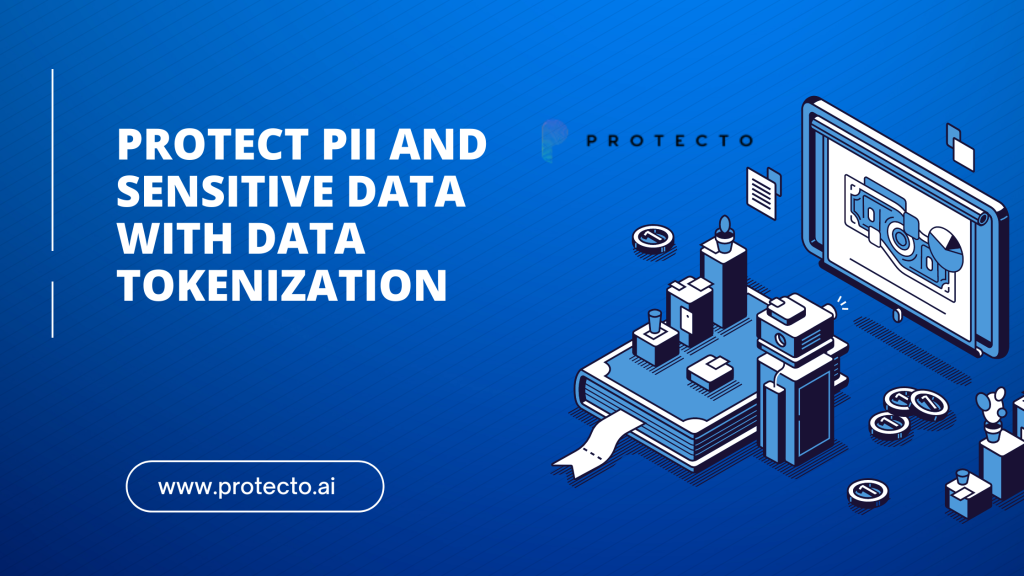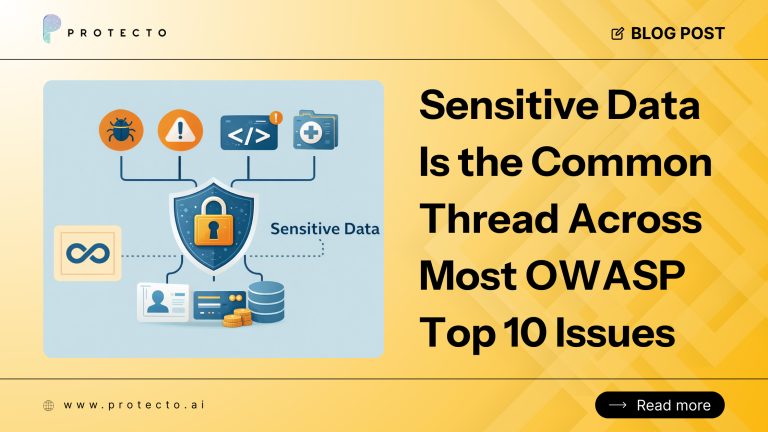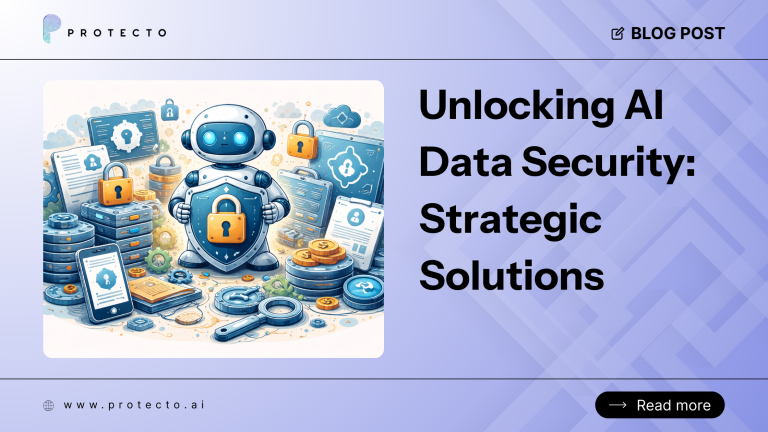To address data privacy threats, organizations are turning to data tokenization—a process where PII and sensitive data, such as social security numbers or bank account numbers, are replaced with random data strings called tokens. Unlike encryption, tokens lack inherent meaning and cannot be reversed to reveal original data. Only the token-generating system can decrypt them back to the original PII data through de-tokenization.
In this blog, we explore how to protect sensitive data with tokenization, common use cases of PII data tokenization, and compare it with encryption to understand its utility in securing valuable data assets.
What is data tokenization?
Data tokenization is a data security method that replaces sensitive data with unique identifiers, known as tokens. The tokens are meaningless in themselves, but they can be used to reference the original data. This makes it much more difficult for unauthorized users to access or misuse sensitive data.
Tokenization is used to protect various types of sensitive data, such as Social Security numbers, passwords, and medical records. By tokenizing sensitive data, organizations can help to reduce the risk of data breaches and protect their customers’ privacy.

There are two main types of data tokenization:
- Format-preserving tokenization: This type of tokenization replaces sensitive data with tokens that have the same format and length as the original data. This makes it easier to integrate tokenized data with existing systems.
- Non-format-preserving tokenization: This type of tokenization replaces sensitive data with tokens that have a different format and length than the original data. This makes it more difficult for unauthorized users to reverse engineer the tokens and access the original data.
Data tokenization is a valuable security measure that can help to protect PII and sensitive data from unauthorized access, use, or disclosure.
Here are some of the benefits of data tokenization:
- Increased data privacy and security: Tokenization helps to protect sensitive data from unauthorized access, use, or disclosure. You can enable secure data storage and transmission without exposing sensitive details.
- Privacy Compliance: Tokenization can help organizations to comply with data protection regulations, such as PCI DSS. This allows for better data obfuscation while minimizing the risk of data breaches and unauthorized access.
- Reduced costs: Tokenization can help to reduce the costs associated with data breaches, such as the cost of customer notification and credit monitoring.
Interesting read: How Data Tokenization Plays an Effective Role in Data Security
How does data tokenization work?
Data tokenization is a data security technique that replaces sensitive personally identifiable information (PII) with unique identifiers, known as tokens. The process of data tokenization typically involves the following steps:
- Identify sensitive data:
The first step is to identify the Personally Identifiable Information (PII) that needs to be protected. PII includes information such as names, addresses, social security numbers, email addresses, credit card numbers, etc.
- Generate random tokens:
A tokenization system generates random, unique tokens for each piece of sensitive data. These tokens are typically long strings of characters or numbers and are generated using a secure cryptographic algorithm.
- Tokenize the data: The sensitive data is then replaced with the corresponding tokens. For example, if a person’s name is “Mary Jane,” the tokenization process will replace it with a token like “abc123xyz456.”
- Create a tokenization map:
To maintain the link between the original sensitive data and its corresponding tokens, a tokenization map is created. This map is stored securely and contains information about which token corresponds to which original PII data.
- Securely store the tokens and map:
The original sensitive data is no longer stored in a readable format in the database or any other system. Instead, only the tokens are stored in the data stores with the mapping stored in a secure vault. The tokenization map, which holds the relationship between the original data and the tokens, must be securely stored and protected.
- Token retrieval and usage:
When authorized systems or users need to use the sensitive data, they provide the token to the tokenization system. The system looks up the token in the tokenization map and retrieves the corresponding sensitive data associated with that token. This data can then be used as needed, and the process is typically transparent to the user or the system interacting with the tokenization system.
Tokenization and Encryption: Key Differences
1. Data Transformation:
- Tokenization: Tokenization replaces sensitive data with random tokens, which have no mathematical relationship with the original data. The actual data is stored separately in a secure data vault or tokenization system.
- Encryption: Encryption transforms data using an algorithm and a cryptographic key to make it unreadable. To access the original data, decryption using the appropriate key is required.
2. Reversibility:
- Tokenization: Tokens are non-reversible. Once data is tokenized, there is no way to retrieve the original data from the token alone.
- Encryption: Encryption is reversible. The original data can be retrieved by decrypting the encrypted data with the correct decryption key.
3. Data Storage:
- Tokenization: Sensitive data is stored in a separate secure location, often referred to as a token vault or tokenization system. Tokens are stored in the primary database or application.
- Encryption: Encrypted data and the decryption keys are both stored together. If the encryption key is compromised, the encrypted data can potentially be decrypted.
4. Data Security Scope:
- Tokenization: Tokenization can be applied to specific sensitive data elements, keeping only the necessary data protected.
- Encryption: Encryption is applied to entire datasets, folders, or files, which may include both sensitive and non-sensitive data.
5. Performance:
- Tokenization: Tokenization generally offers faster data processing and retrieval times since there is no need for complex encryption and decryption processes.
- Encryption: Encryption can have a performance impact, especially with large datasets, as encryption and decryption processes require more computational resources.
Why Tokenization is Better for Protecting PII Data:
- Enhanced Security:
Tokenization offers a higher level of security compared to encryption because tokens hold no intrinsic value and cannot be reverse engineered to reveal the original data. Even if attackers gain access to tokens, they remain useless without the tokenization system.
- Reduced Compliance Scope: Tokenization allows organizations to reduce the scope of compliance audits since sensitive data is stored separately in the token vault. This can simplify the process of meeting regulatory requirements like PCI DSS.
- Minimal Data Exposure:
With tokenization, sensitive data is significantly reduced or eliminated from systems, reducing the potential impact of a data breach. Only the tokenization system requires strict security controls. - Faster Processing:
Tokenization provides faster data processing and retrieval times, as it involves simple token lookups, unlike encryption, which requires resource-intensive encryption and decryption operations.
- Data Segmentation: Tokenization enables organizations to segment data according to sensitivity. Non-sensitive data can remain in the primary database, while sensitive data is stored securely in the token vault, enhancing data management efficiency.
While both tokenization and encryption are valuable data protection methods, tokenization’s non-reversible nature, reduced data exposure, and improved performance make it an attractive option for safeguarding sensitive information and meeting regulatory compliance requirements.
Suggested read: Importance of Consistent Data Tokenization for Seamless Analytics
Real World Use Cases of PII Tokenization
PII (Personally Identifiable Information) tokenization is widely used in various real-world scenarios to protect sensitive personal data while maintaining data usability. Here are some common use cases of PII tokenization:
- Payment Processing:
In the payment industry, PII tokenization is employed to secure credit card numbers, bank account details, and other financial information. Instead of storing actual card numbers, merchants and payment processors use tokens to conduct transactions securely. This minimizes the risk of exposing sensitive payment data during processing and reduces the organization’s PCI DSS compliance scope.
- Healthcare and Electronic Health Records (EHRs):
Healthcare providers and organizations deal with sensitive patient information daily. PII tokenization ensures the privacy of patients’ names, social security numbers, medical records, and other confidential data. Medical researchers can also use tokens for analysis while adhering to strict privacy regulations like HIPAA (Health Insurance Portability and Accountability Act). - Cloud Services and Data Sharing:
Cloud service providers use PII tokenization to secure data shared among multiple clients. This enables safe data collaboration and analysis without revealing the original sensitive information. - Marketing and Analytics:
Marketing agencies and analytics platforms may tokenize customer data to maintain privacy while conducting targeted advertising campaigns and data analytics. This practice allows them to respect data subjects’ rights while still gaining valuable insights. - Insurance and Claims Processing:
Insurance companies deal with extensive customer data during claims processing. PII tokenization safeguards policyholders’ information, preventing unauthorized access and potential data breaches. - Human Resources:
HR departments often handle employee personal data, including social security numbers, addresses, and bank details. Tokenization ensures that employee information remains protected in HR databases, enhancing data security and compliance with privacy regulations. - Government Agencies:
Government entities collect vast amounts of personal data from citizens. PII tokenization ensures the privacy and security of this information, reducing the risk of data leaks and unauthorized access.
In each of these use cases, PII tokenization offers a powerful solution to protect sensitive personal data, ensuring compliance with data protection regulations, and building trust with customers and users. It enables organizations to balance data security with data utility, maintaining the privacy of individuals’ information while allowing data to be used effectively for legitimate purposes.
Enhance your Data Privacy with Protecto’s PII Tokenization
Ensuring compliance and mitigating privacy risks has become a top priority for businesses. Our platform enables you to identify personally identifiable information (PII) and sensitive data, locate potential risks, maintain metadata, and deliver data retention to safeguard privacy and achieve regulatory compliance.

With our intelligent data tokenization solution, you can identify PII, monitor and mitigate data privacy risks. Lock your sensitive PII in a zero-trust secure data privacy vault, that provides a robust solution to store and manage sensitive PII securely. Our intuitive user interface provides guided workflows to help you quickly navigate through the configuration and get started in days. Deliver data tokenization in real-time and scale effortlessly to accommodate high data volumes without compromising on performance.
Protecto is transforming the way enterprises safeguard sensitive information with cutting-edge technology. Schedule a demo or start your free trial to get started today.
Frequently asked questions on PII data tokenization
What is PII tokenization, and how does it protect sensitive data?
PII tokenization is a data security technique that replaces Personally Identifiable Information (PII) with randomly generated tokens. By using this method, sensitive data, such as names, addresses, and social security numbers, is shielded from unauthorized access and data breaches.
How does data tokenization enhance data privacy?
Data tokenization enhances data privacy by rendering sensitive information meaningless to unauthorized individuals. Instead of storing actual PII data, a tokenization system generates unique tokens that serve as placeholders for the original information. This minimizes the risk of exposing sensitive data and boosts data privacy.
Is data tokenization compliant with data protection regulations?
Yes, data tokenization is in line with data protection regulations like GDPR, CCPA, and HIPAA. Since tokenization reduces the scope of sensitive data and ensures that the original information is not stored, organizations can achieve compliance more easily.
How does PII tokenization impact data analytics?
PII tokenization allows organizations to conduct data analytics without accessing or revealing actual sensitive data. By working with tokens instead of PII, companies can derive valuable insights while maintaining the privacy and security of their customers’ information.
How does data tokenization impact user trust and privacy?
Implementing data tokenization demonstrates a commitment to user privacy and data protection. When customers know that their PII is tokenized and secure, they are more likely to trust the organization with their sensitive information.
How does data tokenization help in preventing internal data breaches?
Data tokenization enables organizations to apply robust access controls, restricting access to sensitive data only to authorized personnel. This reduces the risk of internal data breaches and ensures data remains protected from insider threats.




